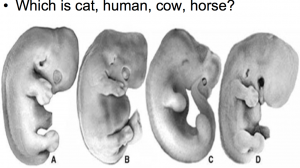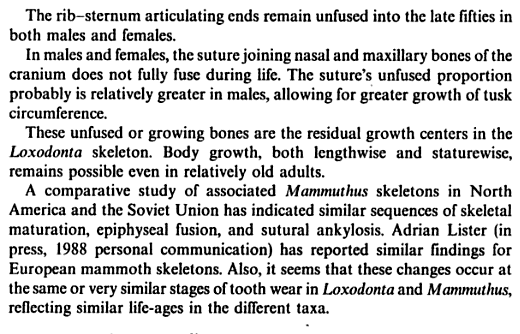Something that I found today while I was reading over an old PDF I had downloaded and put in a big folder was lecture notes from a Upper Class (or even Graduate School) university Biology course from a California State University.
The Lecture notes were entitled “Chapter 10: Postnatal Growth of Fins and Limbs through Endochondral ossification Cornelia E. Farnum Review by Susan Lujan”
The link for the website if you check the URL seems to be from a Biology 680 course (and lecture #4) by a Dr. Stuart S. Sumida from the Laboratory for Vertebrate Paleontology at California State University, San Bernardino (CSUSB)
In the lecture notes, in the section that talks about growth strategies, there is a small part where notes on indeterminate is talked about. Now, I have looked at the idea of indeterminate growth before in previous posts and noted that some animal families or orders have this property where they never stop growing in size, in length, height, weight, and size. These included the usual suspects like fish, reptiles, amphibians, etc. However there was a part where I did not expect which is where the notes seem to suggest that the cartilage in elephants may not completely go away suggesting that elephants may experience a form of indeterminate growth…
Indeterminate growth
- Never ceases, may slow
- Epiphysis remains cartilaginous
- No bony union between epiphysis and diaphysis
- In fish, amphibians, reptiles, the epiphysis may not develop a secondary center of ossification, articular surface is not separated from bone
Elephant
- Epiphyses open, growth throughout life – Dr. Sumida’s note: paedomorphy?
To figure out why is it that some types of animals can continue to grow without stop, the thing about fish, amphibians, and reptiles is that in the long bones that are going through endochondral ossification, there is no secondary center of ossification. I wanted to remind the reader that for the growth plates to even exist, there has to be two types of ossification centers. There is the primary center of ossification that starts in the middle of the long bone, the diaphysis, and there is the secondary center of ossification that starts at the ends of the long bone, the epiphysis. The cartilage that is between the secondary and primary ossification centers are the growth plates, which over time shrink in thickness as the centers continue to grow outward in a way that is similar to the way the periosteum near the outer surface of the cortical bone layer grows outward appositionally. This means, that if the amphibian/fish/reptile is missing the 2nd part (the secondary ossification center) that creates the growth plate, it might be that the concept of “growth plates” don’t exist in these animal creatures.
 Since nearly all animals when in the very early fetus stage look almost exactly alike which is determined by genes that act as directions on how the limbs will be structured, we realize that even the reptile has the same early stages of growth before birth as the human.
Since nearly all animals when in the very early fetus stage look almost exactly alike which is determined by genes that act as directions on how the limbs will be structured, we realize that even the reptile has the same early stages of growth before birth as the human.
It seems that humans before birth develop the structures that will eventually become the bones through some type of cell aggregation known as chondrocyte condensation.
So if the humans at fetuses have cartilage as bone precursors, then the reptiles’ long bones should be similar in composition at least. If they are then missing the secondary ossification centers then there is a tip in the long bones that are never pushed by a 2nd part making the layer of cartilage thinner, as what happens in humans. Like the same type of physiological process we saw in how animal antlers are formed, there is a layer of cartilage or mesenchyme on the ends of the bones that never go away, that is not surrounded by bones clamping down on them, and that means that the bones of these types of animals get longer and longer, which we as humans/mammales don’t have.
(remember that there is a difference between animal horns and animal)
From the PubMed study “Cartilaginous Epiphyses in Extant Archosaurs and Their Implications for Reconstructing Limb Function in Dinosaurs”
Among extant animals, epiphyseal cartilage has been the focus of anatomical descriptions, proposed mechanical and evolutionary models, phylogenetic interpretations, and numerous biomedical studies. Different clades of amniotes vary in the extent to which they retain or ossify their epiphyses. During early limb development in amphibians, turtles, crocodylians, birds, and hypothetically non-avian dinosaurs, a cartilage cone develops within the metaphysis that is connected to the epiphyseal cartilage. Endochondral ossification continues just deep to the epiphyseal region, eventually engulfing and obliterating the cartilage cone, leaving the terminal cartilaginous cap that comprises the epiphysis. In birds, ossification proceeds much as in crocodylians and turtles, but differs in that most of the epiphysis is eventually assimilated into endochondral bone, leaving just the relatively thin hyaline cartilage of the articular surface. Secondary centers of ossification (i.e., bony epiphyses) are absent in turtles, crocodylians, and birds. On the other hand, in mammals and most lizards, secondary centers of ossification develop, leaving only a relatively thin layer of hyaline articular cartilage on the terminal ends of the element. Endochondral ossification continues as chondrocytes hypertrophy, proliferate, and form a growth plate between the metaphyseal bone and epiphyseal cartilage. This scaffold of cartilage cells forms a thin lamina of calcified cartilage that persists as an evenly curved surface on the end of the bone. Despite our understanding of skeletal tissue biology, few studies have attempted to quantify how much of an epiphyseal cartilaginous cap is present, particularly in reptiles.
However, this post is about elephants and how they seem to be growing indefinitely and they are the heaviest land animals in the world. How do their cartilage manage to survive for so long?
I wanted to do more research to see whether this claim that the growth plates of elephants never close true or not. So I googled the term “elephant epiphyses” to see what would appear.
Source #1: From the article “How Elephants Grow: Heterochrony and the Calibration of Developmental Stages in Some Living and Fossil Species” – V. Louise Roth Journal of Vertebrate Paleontology -Vol. 4, No. 1 (Sep., 1984), pp. 126-145 – Published by: The Society of Vertebrate Paleontology
- It states that “In elephants, ontogeny is prolonged and the period of growth is lengthy.”
- Also, in the abstract, “limb bones that complete epiphyseal fusion late in ontogeny also grow more in absolute terms”
Source #2: From a PDF by a person named Gary Haynes in the Anthropology Department in the University of Nevada, Reno entitled “One way to understand mammoths: lessons from actualistic studies of modern elephants”
- Bottom left part of Page 83: Most fractures were created by elephants trampling on elements partly buried in the surface sediments or lying atop the ground. In a few cases, spotted hyenas had first gnawed off an epiphysis, especially common with bones from elephants whose epiphyses had not fused to the shafts at the time of their death.
Source #3: From the book “Mammoths, Mastodonts, and Elephants: Biology, Behavior and the Fossil Record” (Low-ball): Gary Haynes” : Page 350:
These sources show that maybe the reason elephants get so big is because they have epiphyseal cartilage that don’t fused together even at advanged age.
From a 4th source, “The Wild Elephant and the Method of Capturing and Taming it in Ceylon”
(Low-ball): Sir James Emerson Tennent – Sketches of the Natural History of Ceylon The epiphyses were still distinct Page 125 of 295
- The researcher seems to find mammoths that at the age of around 30 years old still had distinct, and rather well kept growth plates. This made the researcher suspect that the ancient mammoths could live to be up to 150 years or even more (300 years old).
“The only attempt which I know of to establish a period historically or physiologically is that of FLEURENS, who has advanced an ingenious theory on the subject in his treatise “_De la Longevite Humaine_.” He assumes the sum total of life in all animals to be equivalent to five times the number of years requisite to perfect their growth and development;–and he adopts as evidence of the period at which growth ceases, the final consolidation of the bones with their _epiphyses_; which in the young consist of cartilages; but in the adult become uniformly osseous and solid. So long as the epiphyses are distinct from the bones, the growth of the animal is proceeding, but it ceases so soon as the consolidation is complete. In man, according to FLEURENS, this consummation takes place at 20 years of age, in the horse at 5, in the dog at 2; so that conformably to this theory the respective normal age for each would be 100 years for man, 25 for the horse, and 10 for a dog. As a datum for his conclusion, FLEURENS cites the instance of one young elephant in which, at 26 years old, the epiphyses were still distinct, whereas in another, which died at 31, they were firm and adherent. Hence he draws the inference that the period of completed solidification is thirty years, and consequently that the normal age of the elephant is _one hundred and fifty_.[3]”
Implications For Height Increase:
There is some evidence like these stories and scientific article which suggest that even though the elephant is the biggest, heaviest animal on land, it still somehow manages to keep the growth plates in its legs around for decades.
Not only that, it seems that there ie vertebrate growth plates which don’t fuse until the 5th or 6th decade of the elephants life meaning that while their shoulder height might have stopped growing keeping their “height” stable, they are still growing anterior and posteriorly into a longer animal.
The evidence for mammoths, compared to the elephants of today is even more astonishing. Some paleontologists are stating from the resources that maybe the mammoths that are found may never stop growing since their bones don’t fuse in the growth plate area.
The evidence shows many times over that the elephants may still be able to grow their bones in terms of volume even into advanced age.
What we see here is something which I didn’t think was possible, especially with such a large in weight land mammal like an elephant. However it makes sense that elephants should have unfused growth plates for so long since they do end up growing to become almost the tallest animals on land.
I had previously believed that the tissue of cartilage would not be strong enough to be able to withstand even the compressive load from the weight of a 200 lb adult human male. The cartilage would not be thick enough or strong enough to hold up that much weight without it being compressed and squeezed to the point where it disappears. This felt like common sense.
The example with the elephant, which is probably the heaviest land animal on earth really makes me rethink about what the cartilage tissue is capable of handling. The biggest elephant ever shot was around 26,000 lbs and 14 feet tall. The mammoths from the ice ages were even bigger.
I guess maybe it might be important to rethink about just strong and durable growth plates really are from the example of how long elephants manage to keep growing.
What is inside the elephant’s DNA that allows them to grow in the vertebrate even in the 6th decade of their life? That is something that the height increase researcher would be interested in knowing.




Your site here is a little hard to read, its too white, i think black as a background is better.